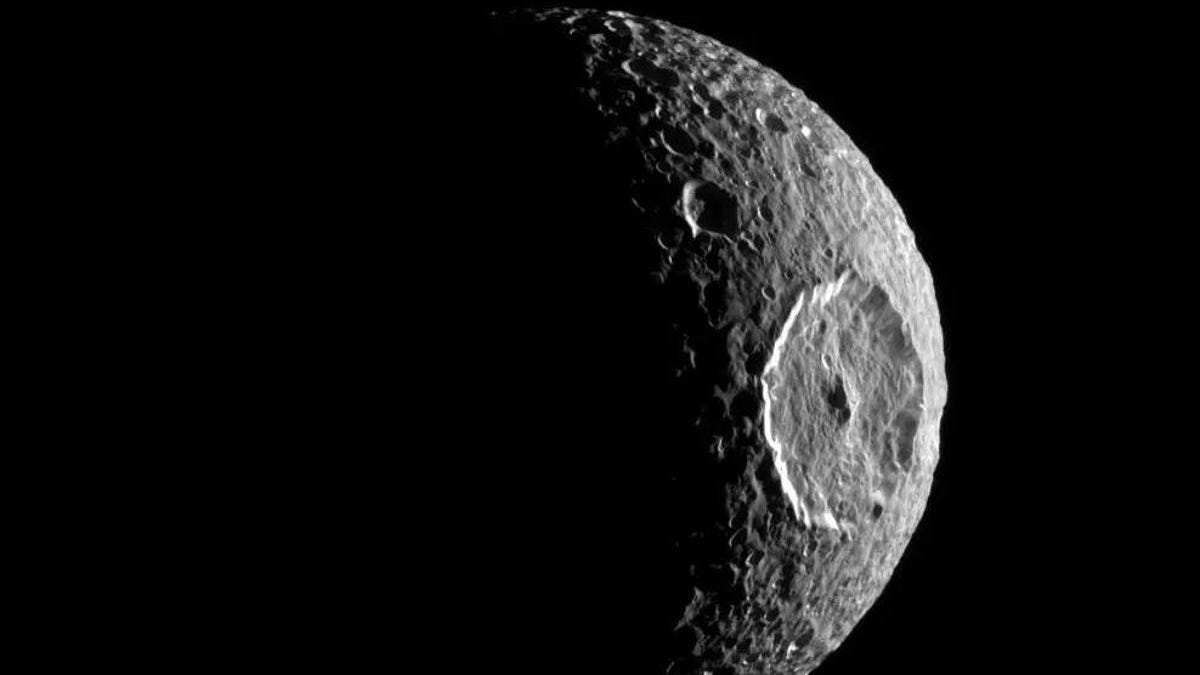
An odd little moon that orbits closely to Saturn just revealed its biggest mystery: a hidden ocean that lies beneath its heavily cratered surface.
Mimas is less than 123 miles (198 kilometers) wide, too small to be perfectly round, and its icy shell is covered with deep scarring from objects slamming into it. Its most prominent impact crater, Herschel, stretches across a third of its face, giving it the nickname Death Star in homage to the Empire’s gigantic space station in Star Wars. The moon is so unassuming that scientists believed it was the least likely place to look for a subsurface ocean, and yet an analysis of Mimas’ orbital motion revealed an ocean 12 to 18 miles (20 to 30 kilometers) beneath its icy shell.
Advertisement
The discovery is detailed in a study published on Wednesday in the journal Nature. Using data from the Cassini space probe, which orbited Saturn from 2004 to 2017, the scientists behind the new study observed the subtle changes in Mimas’ orbit. Based on its motion and spin as it looped around Saturn, the data suggests that Mimas harbors a recently formed ocean that is still evolving.
Advertisement
The ocean is estimated to be around 5 to 15 million years old. By comparison, the internal ocean on Saturn’s moon Enceladus formed around one billion years ago while Jupiter’s moon Europa has hosted an ocean for nearly 4 billion years.
Related article: A Guide to the Unearthly Oceans in Our Solar System
Mimas now joins Enceladus and Europa, as well as Saturn’s moon Titan and Jupiter’s Ganymede, in the list of icy ocean worlds of the solar system, but there could be more out there. Moons that are mainly made of ice are warmed by tides, which melts the ice internally while the outer shell freezes to form a crust that covers it. This elite list of moons makes up the top candidates for life in the solar system, with liquid water being a prerequisite for life on Earth.
Advertisement
“The existence of a recently formed liquid water ocean makes Mimas a prime candidate for study for researchers investigating the origin of life,” Nick Cooper, co-author of the study and researcher at the Astronomy Unit of the School of Physical and Chemical Sciences at Queen Mary University of London, said in a statement.
The ocean on Mimas reached its current depth only recently, or less than 2 to 3 million years ago, according to the study’s simulations. That time span could mean that life may not have had a chance to form just yet, offering a rare early glimpse of the conditions of habitability in the solar system.
Advertisement
Mars may be a hotspot for searching for habitability outside of Earth as it resembles our home planet the most, but the solar system’s icy moons are really where it’s at when it comes to exploring alien life. Luckily, the JUICE mission is on its way to study Jupiter’s icy moons, searching for signs of habitability. Since Cassini plunged to its death into Saturn’s atmosphere, there are plans in the works to send another spacecraft to the ringed planet and its moons, namely Enceladus, but we’ll have to wait a little longer for those to get the green light.
In the meantime, we can ponder what kind of life may exist on Saturn’s disfigured moon.
Advertisement
More: Saturn’s Moon Enceladus Is Belching Up a Key Life Ingredient
Services Marketplace – Listings, Bookings & Reviews